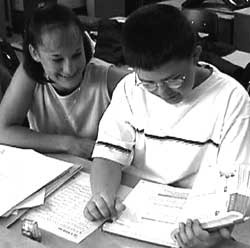Dumas Invests in Future with Permanent Sub Program
 |
| West Texas A&M University senior Andrea Cox, a Permanent Substitute Incentive Program participant at Green Acres Elementary in Dumas, Texas, helps fifth-grader Sheldon Downing with his classwork. |
It's 7:45 a.m., and children are pouring out of school buses ready for another day of class. The phone rings in the principal's office. It is a third-grade teacher who had to rush her father to the hospital because he had a heart attack. She won't be able to teach her class today, and she won't be able to leave the hospital to prepare lesson plans for a substitute.
During a substitute shortage and those hectic 15 minutes before school begins, the principal may likely split the students into groups and send them to other teachers' classes. Or, a teacher's aide or school monitor may fill in while the principal scrambles to find a sub. The principal may even wind up at the front of the classroom for at least part of the day.
Sound familiar? It isn't in the Texas panhandle town of Dumas, population 13,000. Dumas school officials and area colleges are teaming up to ensure the town's 4,200 students and 270 teachers have qualified substitutes on campus every day. Better yet, this partnership may eventually relieve the town's teacher shortage without draining its education budget.
The Birth of an Idea
Until a year ago, the Dumas Independent School District (DISD) relied mainly on a pool of local residents with high school or general equivalency diplomas to fill in for absent teachers. "Most of them don't have college degrees," says Sharla Wilson, principal at Green Acres Elementary in Dumas. "They're just good people who want to help out."
Then DISD superintendent Larry Appel attended a planning session of similar-sized districts in Spring 2000. There, he learned about another district's system of assigning permanent substitutes to each of its campuses on a daily basis and paying them the same salaries classroom assistants earn.
Serendipitously, Appel was the chair of the Moore County Campus Advisory Committee, which just welcomed a satellite campus of Amarillo College to Dumas in January 2000.
"That led me to think about young adults and others who want to go back to college but, because of financial obligations, are unable to quit their jobs to attend school," Appel says. "I thought maybe we could use these people at least 50 or 60 percent of the time and let them attend classes on the other days. Allowing them to work 50 percent of the time would provide them with health insurance, which is so important."
After completing their degrees and obtaining Texas teacher certificates, students participating in the program would be required to teach for five years in Dumas, giving the town a bigger and "homegrown" supply of teachers.
Appel brought up the idea at the annual DISD planning retreat. "The school board was very interested because we struggle to hire minority teachers and other teachers outside the Panhandle area who will stay with us," he says. By August 2000, just in time for the new school year, the DISD Board of Trustees established the Permanent Substitute Incentive Program.
Program Particulars
During each year of program participation, college students must earn a minimum of 30 semester hours toward a degree plan that results in eligibility for a Texas teacher certificate. Those hours must be completed successfully between September 1 and August 31 of the following year, and official transcripts of hours earned must be submitted to the assistant superintendent no later than September 1 of each year.
In September, Permanent Substitute Incentive Program participants receive a lump sum stipend equal to $15 for each semester hour they've completed toward their bachelor's degrees up to a total of 130 semester hours. They also are placed on the local salary schedule at pay grade 1. This makes them eligible for all employment benefits offered to full-time and half-time DISD employees, including professional development and vacation. Because participants agree to teach five years in the district, Dumas has a steady supply of qualified teachers.
"We came up with this plan by looking at the amount of money we were spending on subs over the past few years," says Lawrence Bussard, the assistant superintendent who runs the Permanent Substitute Incentive Program. "During this first year of the program, we're still within what we spent last year for subs-about $200,000. And we're actually ahead because we're training people to work in our system long term."
So far, Dumas partners with two colleges-the Amarillo College branch in Dumas and West Texas A&M University in Canyon-to spread the word about the program to education majors. Along with these two colleges, DISD plans to work with Oklahoma Panhandle State University, about 60 miles north of Dumas in Goodwell, Oklahoma, next year. Nearly 30 potential program participants applied in August 2000 and interviewed with Dumas school principals and Bussard, who selected 20 college students for the program's first year.
Half of the program participants reported to assigned campuses on Mondays, Wednesdays, and Fridays, while the other half reported to the campuses on Tuesdays, Thursdays, and Fridays. Each elementary school received one permanent sub Monday through Thursday and two on Friday. Each junior high received two permanent subs Monday through Thursday and four on Friday. The high school received three permanent subs Monday through Thursday and six on Friday. The permanent subs attended college classes during their days off, the evenings, and the summer term.
Faculty Feedback
Because the permanent subs are assigned to one campus, the program has created stability for the teachers while allowing the subs to gain experience teaching different grade levels and different subjects offered by that campus.
"These subs pretty much know every classroom, every teacher, and most of the kids," says Green Acres Elementary Principal Wilson, who was assigned two program participants for her campus. "When teachers hear one of our permanent subs will be in their classrooms, they love it. They know they don't have to leave such detailed plans. Plus, if there's an emergency, these permanent subs know other teachers well enough that they can ask those teachers for help."
At Green Acres, the permanent subs have an opportunity to teach kindergarten through sixth grade as well as physical education and music classes. This allows the subs to determine their true likes and dislikes, Wilson says. "So when it comes closer to time for them to finish college and get jobs, they already have a good idea where they're going to be happiest."
Andrea Cox, an education senior at West Texas A&M and permanent sub for Green Acres, says she first got the teaching bug when she coached gymnastics in Dumas when she was 16. Her participation in the permanent sub program confirmed that she had made the right career choice. "I really love this program," Cox says. "It's made me realize how much I want to teach."
It also helped her realize she'd rather teach third and fourth graders-not fifth and sixth graders, as she initially thought. Plus, she feels that she is ahead of her college classmates majoring in education but not participating in the program.
"I have learned more by substituting than I have through my observation and field experience at college," Cox says. Being a permanent presence on campus also helps with classroom management, Cox says. "I think the kids look at me like I'm a real teacher. They have that respect for me-they see me all the time and they know who I am. I really feel like they treat me differently from other subs."
Cox, who graduated from Dumas High School, is grateful for the opportunity to teach in her hometown. "I wanted to come back here and teach, and this program provided me with more incentive to do it."
The Challenges
The program has alleviated DISD's need for an average of 30 substitutes a week, but some bugs must be worked out, Bussard says. For example, at the beginning of the school year, permanent substitutes went directly to their assigned campuses, some of which did not necessarily need subs. In these cases, Permanent Substitute Incentive Program participants generally ended up completing administrative tasks while other Dumas campuses needed the subs to teach students.
| Substitute Teachers Unite Take note: Substitute teachers now have a national voice. http://www.nstasubs.org/ |
| More than a year ago, 60 substitute teachers from across the United States met in Washington, D.C., at the first-ever national conference of substitute teachers to form the National Substitute Teachers Alliance (NSTA). At the July 15, 2000, meeting, these teachers discussed their common concerns, including low pay, lack of benefits, and the need for professional training geared toward substitutes. They also approved a substitute teacher bill of rights. For more information on the alliance and the bill of rights, visit the NSTA Web site at http://www.nstasubs.org/. |
In May, DISD installed an automated calling system that contacts Permanent Substitute Incentive Program participants first and notifies them if they are needed at campuses other than their assigned schools.
For the 2001-2002 school year, 18 of the program participants are returning, which is a big boost to the teachers who trained the permanent subs for a year. But the subs' depth of experience introduces another challenge. As program participants advance in their college coursework, their schedules become more rigid and may threaten continued participation in the program.
"It becomes more difficult to keep these subs on a three-day work week when they have more college hours," Bussard says. "Also, some students may want to attend the mini-semesters some colleges offer, and that becomes a problem."
This is where a strong relationship with DISD's partnering colleges really helps, says Renée Vincent, executive director of the Moore County Campus of Amarillo College. "We've worked really hard with these students to try and facilitate their education so that they could substitute teach for the district three days a week," she says.
To assist these students, Amarillo College offers courses in Internet, distance-learning, and telecourse formats in addition to the standard instructor-student format. Officials at Amarillo College, a two-year school, also are trying to bring more college courses to Dumas as well as to ensure these courses are transferable to four-year universities.
"We do our best to assist these students, and we feel like we are a valued partner," Vincent says.
Looking Back
During its first year, the Dumas Permanent Substitute Incentive Program lost only three participants-one who decided she'd rather get a degree in business, one who wanted to finish school more quickly than the program allowed, and one who moved to Houston. Bussard replaced one of these participants during the 2000-2001 school year. "So we'll replace those other two over the summer break. In fact, I'm getting calls now. People are hearing that we have some vacancies," he says. As of June 2001, Bussard had received eight queries for the 2001-2002 school year.
 The permanent substitute program gained national attention when it was featured as an innovative solution to the sub shortage in a January 2001 Pittsburgh Post-Gazette series called "A Substitute for Education."
The permanent substitute program gained national attention when it was featured as an innovative solution to the sub shortage in a January 2001 Pittsburgh Post-Gazette series called "A Substitute for Education."
And what does Appel, the father of the Permanent Substitute Incentive Program, think of the program's introduction? "I am very satisfied with the first year of implementation," he says. "The program is all that I envisioned and will provide the district with homegrown teachers, who, hopefully, will stay with us."
| SEDL Region Substitute Policies |
| In May 2000, the National Education Association (NEA) released their study findings on credentialing, licensing, and training standards for substitute teachers in the 50 states, Puerto Rico, the District of Columbia, and the federal school systems. The following findings, as well as innovations that prevent substitute teacher shortages, were collected from state NEA affiliates and state education agencies, and they are on NEA's website at http://www.nea.org |
| Arkansas Arkansas has no requirements concerning substitutes. Some of the state's 310 school districts have their own local policies, and they set the pay scales. Before this school year, substitute qualifications were left entirely up to school districts. But a law that the Arkansas Education Association introduced and the state legislature recently passed now requires substitute teachers who teach the same class for more than 30 consecutive school days to have either a bachelor's degree from an accredited college or university or an Arkansas teacher's license. The law exempts those who substitute for non-degreed vocational teachers, and it allows the state education department to grant a waiver if the requirement creates an undue hardship on a district. One district uses a temporary service to get substitutes. For the past few years, it has been more difficult for districts to find enough substitutes, much less enough qualified ones. |
| Louisiana Louisiana has a critical shortage of certified teachers now, its lack of substitute teachers is even worse. There are no uniform rules for substitutes. Some schools 'sweeten the pot' to get higher-quality substitutes. Temporary services are heavily courting several larger districts. |
| New Mexico New Mexico has no requirements for substitute teachers, and the lack of substitutes makes it doubtful that any will be adopted soon. Funds for making substitute teaching more attractive are not available in most districts. There are shortages almost everywhere, largely because of the pay. The attorney general ruled that substitute teachers must be licensed, and legislation has been passed authorizing the state education department to do so. The school districts are required to approve a list of substitutes who can then be licensed for up to three years if they are at least 18 years old. |
| Oklahoma Oklahoma's state guidelines govern the credentials necessary for substitute teaching, but the state has no exemplary substitute teacher programs. Many classes must double up because of a lack of substitutes. Most districts pay $40 to $55 daily for substitutes. Lower rates are paid to those who are not certified. The Tulsa Public Schools (the largest district in the state) just raised substitutes' pay to $90 daily in order to recruit substitutes. Substitutes do not have collective bargaining rights. |
| Texas Texas has no state substitute teacher requirements, according to the Texas Education Agency. Local districts decide what substitute standards to enforce in their own districts. |
Next Article: Tough Enough to Teach: Voices from the Field

